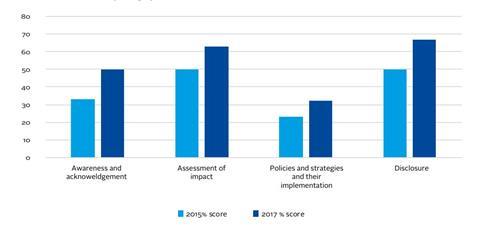Below is a summary of the results of the PRI-coordinated engagement on water risks in agricultural supply chains.
Main findings
- Based on the 32 companies that were benchmarked in 2017, 27 companies (84%) improved their disclosure of water risks and how they managed them in agricultural supply chains
- 84% of companies reported to CDP Water in 2017 compared to 66% in 2015.
- The most improved company increased its disclosure score by 44%
- Awareness and acknowledgement of water risks in agricultural supply chains increased – by 50% in the median score.
- The number of companies explicitly claiming to assess water risks across their entire direct operations and supply chain (not specifically agricultural suppliers) rose from 3% to 25% between 2015 and 2017.
General findings
- More companies are offering better disclosure on water risks in agricultural supply chains. A larger number of companies are now reporting on their waterrelated content publicly as well as providing more comprehensive disclosures.
- Leading companies have moved beyond targeted policies to engage with key suppliers on water risks. Many companies have policies and standards in place that set environmental and/or water expectations on suppliers. Only 25% of the these show strong evidence that they are measuring if supplier water management responses are effective and support local water stewardship strategies.
- The focus of most companies’ water strategies remains on direct operations as opposed to suppliers. The focus of most companies’ water strategies remains on direct operations, despite an increase in the number of companies explicitly claiming to assess water risks across the whole of their direct operations and supply chain.
- Many companies manage water risks as part of a general sustainability strategy and not as a standalone agricultural supply chain issue. While some leading companies are taking steps to embed water stewardship strategies into corporate and business strategy, the research found that other companies manage water risks as part of a general environmental strategy. Responsibility for water issues tends to be bundled up with other sustainability and environmental topics, which may provide the company with a holistic perspective when addressing the issues.
Download the full report
-

Investor guide on water risks in agricultural supply chains
March 2018
Growing water risk resilience: an investor guide on agricultural supply chains
- 1
- 2
- 3
- 4
- 5
- 6
- 7
- 8
- 9
- 10
- 11
- 12
- 13
- 14
- 15
- 16
- 17
 Currently reading
Currently readingEngagement results






















